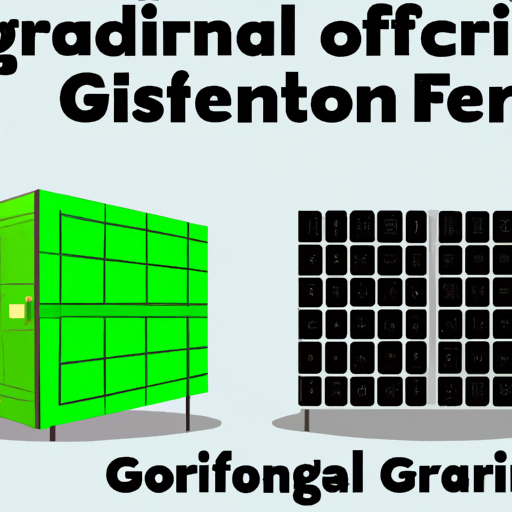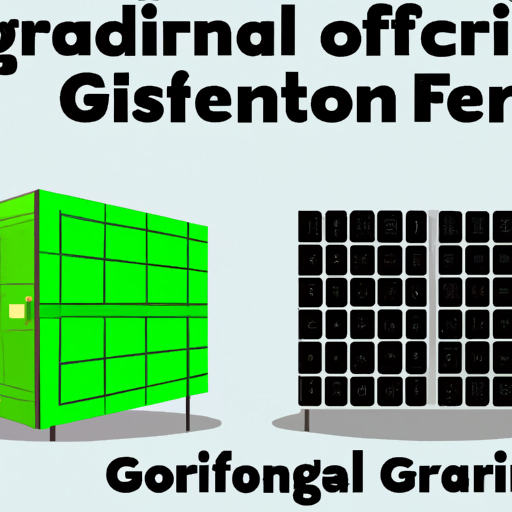Have you ever wondered how to size a generator for an off-grid solar system? When it comes to living off the grid, you need a reliable power source to supplement your solar panels, especially during those cloudy days or long winter nights. It’s important to ensure that your generator is properly sized to meet your energy needs without overloading it or wasting fuel. In this article, we’ll dive into the details of sizing a generator and help you understand the factors involved.
Sizing a generator for an off-grid solar system involves considering several key factors. Firstly, you need to determine your average daily energy consumption. This includes all the appliances and devices you use on a regular basis, such as lights, refrigerators, water pumps, and electronics. Next, you’ll need to calculate the surge or peak power requirements for your system. This refers to the extra power needed to start up certain appliances, like air conditioners or well pumps.
Another important factor is the battery bank capacity. Your generator should be able to replenish the energy stored in your batteries during periods of low solar production. It’s crucial to ensure a proper balance between your solar panels, batteries, and generator to maintain a consistent power supply. Lastly, consider the fuel efficiency and run time of the generator. You want a generator that can run for long periods without constant refueling, especially during prolonged bad weather.
In conclusion, sizing a generator for your off-grid solar system involves understanding your energy consumption, peak power requirements, battery capacity, and run time. By considering these factors, you can ensure that you have a reliable backup power source that meets your needs without wasting fuel or overloading the generator. In our upcoming article, we’ll delve deeper into each of these factors and provide you with practical tips on sizing a generator for your off-grid lifestyle. Stay tuned!

What is an Off-Grid Solar System?
Definition
An off-grid solar system refers to a system that operates independently from the traditional power grid. It generates and stores its own electricity, making it suitable for remote locations or areas with unreliable grid connections. One of the essential components of an off-grid solar system is a generator, which serves as a backup power source.
Components
Apart from the generator, other key components of an off-grid solar system include solar panels, batteries, a charge controller, an inverter, and a distribution panel. The solar panels capture sunlight and convert it into electricity, which is then stored in batteries for later use. The charge controller regulates the charging process to prevent overcharging or damage to the batteries. The inverter converts the stored DC (Direct Current) electricity into AC (Alternating Current) electricity, which is suitable for powering household appliances. The distribution panel is responsible for distributing electricity to different circuits and devices within the system.
Benefits
There are several benefits to using an off-grid solar system. Firstly, it provides energy independence, allowing you to generate and use your own electricity without relying on the grid. This can be particularly useful in remote locations or during power outages. Additionally, off-grid solar systems can help reduce electricity bills and lower carbon emissions since they rely on renewable energy sources like the sun. Moreover, these systems can be tailored to suit individual energy needs, making them highly customizable.
Importance of Sizing a Generator for an Off-Grid Solar System
Reliable Power Supply
One of the main reasons for sizing a generator properly in an off-grid solar system is to ensure a reliable power supply. While solar panels generate electricity during the day, there may be times when the energy generated is insufficient to meet the demand, especially during extended periods of cloudy or rainy weather. In such cases, a generator can be used to supplement the solar power and provide a consistent supply of electricity.
Optimum Performance
Properly sizing a generator is crucial for achieving optimum performance in an off-grid solar system. If the generator is too small, it may struggle to meet the peak load demands and result in frequent overloading or shutdowns. On the other hand, an oversized generator may lead to excessive fuel consumption and inefficient operation. By selecting the right generator size, you can ensure that your off-grid solar system operates efficiently without any performance issues.
Avoiding Overloading
Overloading is a common problem when it comes to off-grid solar systems. An overloaded system occurs when the total demand for electricity exceeds the capacity of the generator or other components, which can lead to component damage, reduced system lifespan, and potential safety hazards. Sizing the generator correctly helps prevent overloading by ensuring that it can handle the maximum power requirements of the system, even during peak load periods.
Factors to Consider When Sizing a Generator
Power Consumption
To determine the appropriate generator size, you must first assess your power consumption needs. Start by listing all the appliances and devices that you intend to power with your off-grid solar system. Determine their wattage ratings, which can usually be found on their labels or in the user manuals. Add up the wattages to get the total power consumption of your system. Keep in mind that certain appliances, such as refrigerators or air conditioners, may have higher wattage requirements during start-up.
Peak Load
Apart from the average power consumption, it’s crucial to consider the peak load demands of your system. Peak load refers to the highest power consumption demand that your off-grid solar system will encounter. This usually occurs during periods when multiple high-consumption devices are running simultaneously. Assess your daily energy usage patterns and identify the time periods when you tend to have the highest demand. Take into account any additional load that may arise in the future, such as the addition of new appliances or increased energy requirements.
Efficiency of Solar System
The efficiency of your solar panels and battery storage system is another factor to consider when sizing a generator. Solar panel efficiency refers to how effectively the panels convert sunlight into electricity. Higher efficiency panels may produce more power, allowing you to rely less on the generator. Additionally, the efficiency of the battery storage system also affects the overall system performance. If your batteries can store and release energy efficiently, you may require less generator backup.

Calculating Power Consumption
Assessing Appliance Wattage
When calculating power consumption, it’s important to accurately assess the wattage of each appliance. This information can usually be found on the appliance itself or in the user manual. If the wattage is not provided, you can use a Watt Meter to measure the power consumption of the device while it is in use. Make sure to account for any appliances that may not be in regular use but may require power backup from the generator.
Estimating Daily Energy Usage
Once you have the wattage for each appliance, estimate the number of hours each device is used daily. Multiply the wattage by the number of hours to get the watt-hours (Wh) consumed by each device per day. Add up the watt-hours for all devices to determine the total daily energy usage of your system.
Determining Total Power Requirement
To determine the total power requirement for your off-grid solar system, you need to calculate the peak load. Identify the appliances and devices that run simultaneously during high-demand periods. Add up their wattages to get the peak load in watts. This will help you determine the minimum generator capacity required to handle the maximum power demand of your system.
Determining Peak Load
Identifying High-Demand Periods
To accurately calculate the peak load, identify the periods during the day when you have multiple high-consumption devices running simultaneously. This may vary depending on your lifestyle and energy usage patterns. For example, the morning rush hour when everyone is getting ready for work or school, or evenings when many appliances and lights are in use simultaneously.
Accounting for Start-Up Power
Certain appliances, such as refrigerators or air conditioners, require additional power during start-up. This is known as the start-up power or surge power. When sizing a generator, it’s important to take into account the surge power of these devices to ensure that the generator can handle the initial power spike without overloading.
Considering Additional Load
When determining the peak load, consider any future additions or changes to your off-grid solar system. If you plan to add more appliances or devices in the future, account for their power requirements. This will help ensure that your system can accommodate any increase in energy demand without overloading the generator.
Assessing Solar System Efficiency
Examining Solar Panel Output
Solar panel output refers to the amount of electricity that the panels can generate under specific conditions. Higher output panels can generate more power, reducing the reliance on the generator. Consider the efficiency and output of your solar panels to determine the amount of power they can provide for your off-grid solar system.
Factoring in Batteries’ Efficiency
The efficiency of the battery storage system affects how effectively energy is stored and released. Higher battery efficiency means less energy loss during charging and discharging. Consider the efficiency of your batteries to determine how much backup power will be required from the generator.
Considering Energy Losses
When sizing a generator, it’s important to consider energy losses within the system. Energy losses can occur during the conversion of DC to AC power by the inverter and during transmission from the batteries to the devices. These losses can vary depending on the quality of the components and the wiring used. Taking energy losses into account will help ensure that the generator size compensates for these losses and provides sufficient power to meet the actual energy requirements.
Choosing the Right Generator Size
Matching Generator Capacity
Once you have determined the total power requirement and peak load of your off-grid solar system, it’s time to choose the right generator size. The generator capacity should match or exceed the peak load demand to ensure a reliable power supply. It’s recommended to choose a generator with a capacity that is at least 25% higher than the peak load to allow for extra headroom and to avoid frequent overloading.
Considering Generator Technology
When selecting a generator, consider the technology that best suits your needs. There are two main types of generators commonly used in off-grid solar systems: diesel generators and propane/natural gas generators. Diesel generators are known for their efficiency and longevity, making them a popular choice. Propane/natural gas generators, on the other hand, offer cleaner emissions and are generally quieter.
Safeguarding Against Overloading
Avoiding overloading is crucial to ensure the longevity and proper functioning of your off-grid solar system. Oversized generators can handle higher loads without overloading, but they may operate less efficiently. It’s essential to strike a balance between generator size and performance to optimize both power generation and fuel consumption. By properly sizing the generator, you can safeguard against overloading and protect the system components.
Ensuring Generator Compatibility
Matching Voltage and Phase
It’s important to ensure that the generator’s voltage and phase are compatible with your off-grid solar system. The voltage should match the system’s voltage requirements, usually either 120V or 240V. Additionally, check if the system operates on single-phase or three-phase power and choose a generator that matches the required phase.
Considering Generator Type
Consider the type of generator that best suits your off-grid solar system. Portable generators offer flexibility and ease of use but may have lower power capacities. Standby generators, on the other hand, are permanently installed and provide higher power capacities. They are typically fueled by propane or natural gas and can automatically start and stop when power is needed.
Assessing Fuel Availability
Before selecting a generator, consider the availability and cost of fuel in your area. If you live in a remote location, it’s important to ensure a consistent supply of fuel for your generator. Analyze the cost and feasibility of fuel delivery or storage to ensure uninterrupted power supply from your generator.
Installation Requirements and Considerations
Space and Location
When installing a generator for your off-grid solar system, consider the space and location requirements. Generators require sufficient space for proper ventilation and maintenance. They should be installed in a well-ventilated area, away from flammable materials and with adequate clearance on all sides for airflow and ease of access.
Ventilation and Exhaust
Generator installations require proper ventilation to ensure the safe operation of the system. Exhaust gases from the generator should be directed outside to prevent carbon monoxide buildup. Install exhaust pipes or venting systems to securely remove exhaust gases away from the living areas.
Maintenance and Upkeep
Regular maintenance and upkeep are essential for the proper functioning of a generator. Follow the manufacturer’s guidelines for routine maintenance, such as oil changes, filter replacements, and inspections. Ensure that you have the necessary tools and knowledge to perform basic maintenance tasks or hire a professional if needed.
Conclusion
Sizing a generator for an off-grid solar system is crucial to ensure a reliable, efficient, and optimized power supply. By considering factors like power consumption, peak load, solar system efficiency, and generator compatibility, you can determine the appropriate generator size for your off-grid solar system. Proper sizing not only prevents overloading but also ensures a dependable power supply during high-demand periods and unfavorable weather conditions. With a well-sized generator, you can enjoy the benefits of an off-grid solar system and have a reliable source of electricity for your needs.




